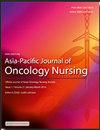指压治疗癌症相关淋巴水肿的前景:范围综述
IF 2.4
3区 医学
Q1 NURSING
引用次数: 0
摘要
目的穴位按摩被广泛用于有效治疗癌症相关症状;然而,有限的证据已经看到应用穴位按摩在管理癌症相关淋巴水肿(CRL)。本研究旨在识别、描述和绘制目前使用指压法预防和管理CRL的证据。方法本综述遵循Arksey和O 'Malley的方法和乔安娜布里格斯研究所的范围评估指南进行。系统检索了8个英文数据库和4个中文数据库,检索时间为成立至2023年10月20日,更新时间为2024年7月20日。参考书目是手工检索的。两名独立审稿人进行研究选择和数据提取。分歧通过与第三审稿人讨论或协商解决。一个叙事综合进行总结和综合的发现。结果共纳入2010 ~ 2023年发表的文献16篇。大多数研究(n = 11)来自中国。共纳入6项随机对照试验(rct)、4项准实验研究、1项回顾性队列研究、1项定性研究、3项综述和1份报告。9项研究采用穴位按压,1项采用推拿,1项采用经皮穴位电刺激。内关(pc6)、河谷(l4)、鉴井(gb21)、曲池(l11)、赤策(l5)是最常用的腧穴。不同研究的剂量不同。穴位按压由训练有素的护士或患者进行。穴位按压可改善淋巴水肿管理、肢体功能、生活质量和炎症因子。结论穴位按压在预防和治疗CRL中的有效性。建议进一步进行严格的研究,特别是设计良好、涉及不同人群的随机对照试验。本文章由计算机程序翻译,如有差异,请以英文原文为准。
The promising application of acupressure for management of cancer-related lymphedema: A scoping review
Objective
Acupressure is widely used to effectively manage cancer-related symptoms; however, limited evidence has been seen on the application of acupressure in managing cancer-related lymphedema (CRL). This study aims to identify, describe, and map the current evidence that used acupressure for CRL prevention and management.
Methods
This review was conducted following Arksey and O’Malley’s methodology and Joanna Briggs Institute guidance for scoping reviews. A systematic search was performed in eight English databases and four Chinese databases from inception to Oct 20, 2023, and updated on July 20, 2024. Reference lists were hand-searched. Two independent reviewers performed study selection and data extraction. Disagreements were solved through discussion or consultation with a third reviewer. A narrative synthesis was performed to summarize and synthesize the findings.
Results
A total of 16 articles published from 2010 to 2023 were included. The majority of the studies (n = 11) were from China. There were six randomized controlled trials (RCTs), four quasi-experimental studies, one retrospective cohort study, one qualitative study, three reviews, and one report. Nine studies examined acupressure, one employed tuina, and one utilized Transcutaneous Electrical Acupoint Stimulation. Neiguan (PC 6), Hegu (LI 4), Jianjing (GB 21), Quchi (LI 11), Chize (LU 5) were most commonly used acupoints. The dosage varied among studies. Acupressure was performed by trained nurses or patients. Acupressure showed improvements in lymphedema management, limb function, quality of life, and inflammatory factors.
Conclusions
The review concluded the effectiveness of acupressure in CRL prevention and treatment. Further rigorous research is recommended, particularly well-designed RCTs involving diverse populations.
求助全文
通过发布文献求助,成功后即可免费获取论文全文。
去求助
来源期刊

Asia-Pacific Journal of Oncology Nursing
Multiple-
CiteScore
2.80
自引率
11.10%
发文量
136
审稿时长
31 days
 求助内容:
求助内容: 应助结果提醒方式:
应助结果提醒方式:


